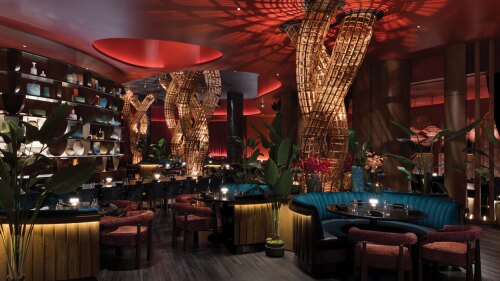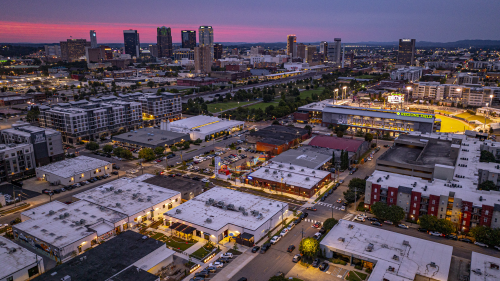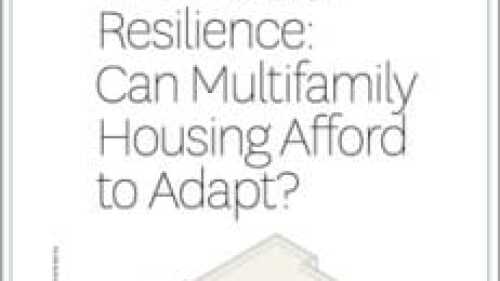Property Types
Hotels and Resorts
The hotel industry in the United States faces complex challenges in 2025, according to Jan Freitag, national director of hospitality analytics for the CoStar Group. During the “State of the U.S. Hotel Industry” presentation at the ULI 2025 Spring Meeting in Denver, Colorado, Freitag highlighted the challenges facing the hotel business amid macroeconomic uncertainty.
Once a sprawling expanse of uncharted land, Las Vegas, Nevada, has evolved into the entertainment capital of the world, a gaming super-hub, and a premier destination for sports. This remarkable transformation didn’t happen overnight; it stemmed from decades of strategic planning, investment, and visionary zoning recommendations.
Las Vegas is unlike any other place in America. Each year it draws more than 40 million visitors to the dazzling casinos and hotels that “turn night into daytime”—and transform the city into a glittering jewel in the desert. With 164,000 hotel rooms, Las Vegas is the largest hospitality market in the U.S.—outpacing Orlando, Florida, the next biggest market, by approximately 15 percent, according to JLL.
Industrial
Standing in the shadow of Regions Field and within earshot of Railroad Park, Birmingham’s Urban Supply hints at what the next chapter of downtown life could look like. Once-quiet brick warehouses are being steadily reimagined into patios, storefronts, and gathering spaces along a new pedestrian alley. Early tenants have begun to open their doors, and programming is slowly bringing people into the district. While the project is still in its early stages, the framework is in place for a vibrant hub that will grow block by block in the years ahead.
What trends are shaping the future of the industrial sector? Four experts from ULI’s Industrial and Office Park Development Council talk about the industrial submarkets and property types that offer the greatest opportunities, challenges developers face in bringing new projects to market, ways artificial intelligence and emerging technologies are reshaping the sector, tenant priorities, and other key trends.
After a quiet first half of 2024, CMBS originations increased 59 percent in Q3 on a year-over-year basis, according to the Mortgage Bankers Association’s Quarterly Survey.
Mixed-Use
New resilience framework touches on infrastructure, economy, equity, housing, and cultural vitality.
The OAK project began in 2009, when a development firm set their sights on the corner of Northwest Expressway and North Pennsylvania Avenue, the state’s most important and busiest retail intersection. As the region’s only parcel capable of supporting a vertically integrated project of this scale and density, that land represented an opportunity to create something truly special.
Following a masterplan adopted by British Land, the AustralianSuper pension fund, and the Southwark Council, developers are now seven years into a 15-year project to transform a 53-acre (21.44 hectares) parcel of industrial land and a former quay into a community that will include as many as 3,000 new homes, office, retail, leisure, and entertainment space.
Multifamily
As congregations across North America grapple with shrinking membership and aging facilities, a new opportunity is emerging: transforming faith-owned land into affordable housing and community-serving spaces. At the 2025 ULI Fall Meeting in San Francisco, panelists in the session “Spiritual Brownfields: Declining Congregations and Opportunities for Housing on Faith-Owned Land” explored how churches and developers are partnering to bring mission-driven housing to underused sacred sites.
At the 2025 ULI Fall Meeting in San Francisco, leaders from across the development and construction industries discussed how they are adapting to a volatile yet stabilizing housing landscape in a session called “Report from the Field: Wrestling with the Cost of Housing Construction.” Despite headlines about tariffs, labor shortages, and inflation, the panelists agreed that the cost environment has settled into what one called a “new normal.”
A panel of insiders reveals what’s true—and false—about the housing crisis and how to fix it.
Office
What is within our collective grasp may be nothing less than the fundamental revaluation and reinvention of what we mean by the city. It is only within the wider urban context of the life of cities that it becomes possible to address the future of what we may or may not continue to describe as the office. Learn three cautionary rubrics important to successful office design.
Under the “new normal” of retailing, shopping is an “experiential” activity done in more urban settings, there are lots of un- or under-employed consumers focused on prices, and Wall Street performance correlates with retail trends. Jon Eisen, managing principal of The Eisen Group in Washington, D.C., offered this take at an industry roundtable at ULI’s Spring Council Forum in Phoenix, Arizona. Read what panelists had to say about the future of retail and commercial property.
Laws and regulations affect all types of real estate in all markets, but perhaps nowhere more profoundly than in the nation’s capital. For this reason, federal rules and regulations for leased facilities are watched closely by private sector owners and developers of office space. Read what a panel of industry insiders at the recent ULI Washington Real Estate Trends Conference had to say about this topic.
Residental
Housing that truly accommodates the needs of multiple generations living under one roof and that promotes interaction among them is a niche far from being filled, W. Aaron Conley, president and managing principal of Third Act Solutions, said during a ULI Terwilliger Center on Housing webinar in June.
A Los Angeles developer and architect use a new small-lot ordinance to build single-family houses at a garden-apartment type of density.
A new report from NYU’s Furman Center underscores the challenges of retrofitting New York City’s multifamily housing stock against the threat of rising sea levels.
Retail
For decades, civic leaders have tried to revitalize Market Street, San Francisco’s central thoroughfare, only to see their efforts founder. “I sometimes call it the great white whale of San Francisco,” says Eric Tao, managing partner at L37 Development in San Francisco and co-chair of ULI San Francisco. “Every new mayor, every new planning director, every new economic development director has chased that white whale.” This year, however, an international competition of ideas hosted and run by ULI San Francisco, with support from the ULI Foundation, generated fresh momentum for reimagining the boulevard. The competition drew 173 submissions from nine countries and sparked new conversations about the future of downtown San Francisco.
As aging retail continue to evolve, one increasingly popular trend has been to redesign malls as town centers—recalling a time when such commercial districts were the heart and soul of a community. Mall–to–town center retrofits are emerging throughout the nation, especially in suburban communities, where pedestrian-friendly, mixed-use environments are highly attractive to millennials now raising families.
Consumers have kept a steady foot on the gas this year. A record-high 197 million consumers shopped in stores or online over the Thanksgiving holiday weekend, according to the National Retail Federation (NRF). The NRF forecasts that holiday sales will grow between 2.5 percent and 3.5 percent, with total retail spending in the United States falling between $979.5 billion and $989 billion during November and December. That forecast also is consistent with NRF’s annual U.S. sales growth—between 2.5 percent and 3.5 percent—for 2024.


















